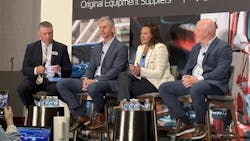Tariffs, regulations, and economic trends impact today’s commercial vehicle market
Key takeaways
- Economic indicators suggest a downturn, with inflation reaccelerating and manufacturing flatlining, raising concerns about a possible recession.
- Tariffs are increasing costs and reducing global competitiveness, while also contributing to economic slowdown by vaporizing economic activity.
- Regulatory changes, including EPA emissions standards and EV technology investments, are creating both challenges and opportunities for industry growth.
PONTIAC, Michigan—The Motor & Equipment Manufacturers Association (MEMA) held its annual Commercial Vehicle Outlook Conference here this week, bringing together executives of vehicle suppliers across the Motor City and nationally. While conversation and presentations were aimed at the suppliers of trucking OEMs, their insights were valuable for fleet owners and truck purchasers alike.
The economy, tariffs, and regulations brought on by the Trump Administration dominated the topics covered at the conference. Attendees heard commentary from Kenny Vieth, president of ACT Research; Nicole Oreskovic, VP of sales and marketing at Bendix; Jeff Zawacki, VP of the Advanced Technology Group at Hendrickson; Matt Wolfe, president of the Americas at SAF Holland; and Jeffrey Crane, partner at Bain and Company.
The economic pressures shaping the commercial vehicle market
Though it’s no surprise, MEMA’s presenters and speakers had few positive things to say concerning the current economy and how it could potentially impact trucking and the commercial vehicle market.
ACT Research’s Vieth laid out what he’s seeing in terms of inflation, its impact on the general economy, and whether a recession is a possibility.
VIETH: "We're in the very early innings right now, but inflation is reaccelerating," Vieth said. "This is going to continue through most of next year."
"Manufacturing has been flatlining for the past five or six quarters, the housing market is down, and ... generally, housing data has been down and moving lower as interest rates have remained elevated."
“We are seeing a downturn in real disposable personal income. Six or seven months ago, that was running at about a 3% rate—we're below a 2% rate on real disposable personal income right now.”
"Our risk [of a recession] right now is at 35%. Back in April, we were at 50%, but we keep adding to the uncertainty. We keep adding to the tariffs. The Yale Budget Lab says that we could see tariffs up to 22%, which is almost a 10x increase on a year-over-year basis from 2024.”
However, Vieth is hopeful that good stewardship will keep the U.S. economy afloat:
VIETH: “I think consumer wealth and solid business balance sheets should keep the U.S. economy from falling into a recession. But I don't think it would take too much of a push right now.”
SAF Holland’s Wolfe brought a perspective that’s based more on the trucking side. His overall outlook also wasn’t so positive.
WOLFE: “Carriers buy equipment when they're making money, and they're not making money. A lot of the other economic factors don't point to them becoming more profitable. Normally, I'm a very optimistic person, but after hearing ... where the market is, I think we're in for a really tough 2025 and 2026."
When asked whether he believes lowering interest rates will entice fleet owners to purchase more trucks and spur the trucking manufacturing industry, Wolfe said not to count on it.
WOLFE: “It certainly won't hurt—I think it will help. But at the end of the day, ... freight rates need to increase so [carriers] can be more profitable.”
See also: When will freight demand improve? Trucking analyst offers outlook
Tariffs and trade policies drive uncertainty in operations and equipment costs
While tariffs have the potential to raise the price of goods (thankfully, that hasn’t happened much yet), they also have the potential to stunt the global growth and competitiveness of U.S. manufacturers, especially for automotive and truck manufacturers and suppliers, according to Vieth.
VIETH: “We could talk about the craziness of tariffing, not just our foes but our friends. And then, getting to what you all do—steel, aluminum, copper,” Vieth said to the crowd of automotive and trucking suppliers. “So, you are becoming more uncompetitive in the global market with the actions that are occurring today.”
“If you're building north or south of the U.S. border and importing to the United States, you no longer have that slight competitive advantage that you did.”
But while tariffs haven’t raised prices much yet, Vieth believes they have caused the economy to spiral.
VIETH: “The economy was in very good shape at the beginning of 2025. The debate in our shop was, ‘Is GDP going to be growing at 2% or 2.5%?’ back in January and February. The debate by the time we got to April was ‘Above or below 1%?’, and now we've settled out into the mid ones. We're talking almost a full percentage point of economic activity that we believe has been basically vaporized by tariffs.”
Bain and Company’s Crane provided a macro look and explained that it’s going to be very difficult to determine the long-term outcome of Trump’s tariffs. If the goal is to rebalance the trade deficit, that could have major implications globally.
CRANE: “On the net goods importer side, the U.S. is just far bigger than any other country. If you think about this sort of realignment, it’s unclear to what extent Trump's policies will be successful in shrinking the deficit, but if the U.S. deficit does start to shrink materially, that creates big issues for the net exporters to find new markets for their goods. This is all playing for a much bigger story than just the U.S. tariffs for the headlines every day.”
“There’s going to be, around the world, more bilateral trade deals, and that’s going to create more uncertainty.”
Further, the “unknown” of tariffs and trade has paralyzed some companies—at least until they can see some stability with the United States-Mexico-Canada Agreement (USMCA).
ORESKOVIC: “I think the biggest challenge we have right now in pulling the trigger as these business cases are developed and defined is what's going to happen with USMCA? That uncertainty, I think, makes it a little bit challenging to actually react.”
“We've got plans in place. We're not taking any drastic measures, though, until we see how this unfolds in the next six months and stabilizes, because there's a significant cost to those types of moves, right? We want to make sure that we're doing it strategically, not just reacting to the latest tariff headline.”
But tariffs didn't signify complete doom and gloom at the MEMA Commercial Vehicle Outlook conference. Leaders from SAF Holland and Bendix see them as an opportunity.
Oreskovic thinks the uncertainty helped bring out both internal and external partnerships and collaborations that otherwise would not have happened.
ORESKOVIC: At Bendix, “we've come together, and we've got cross-department teams really aligned on how we're going to address these issues that we're facing, but also the industry in and of itself. ... I think it’s really going to allow us to move forward as an industry to get through this.”
WOLFE: “I think the new thing from this past 12 months really has been the trade policy and tariffs—so, not a good thing. But it has allowed some people within our organization to shine in stepping up and helping tackle the problem. I think in times of crisis, it's really interesting to see which team members step up and perform really well.”
See also: Unpacking trucking's ‘FUN’ future. Is this the new normal?
Regulatory shifts affect truck purchasing, emissions goals, and investment decisions
Regulations make an impact on the industry in significant ways, according to the group of speakers.
VIETH: “Unfortunately, political policy risks to the forecast are substantial. ... We’ve got tariffs, inflation, interest rates—are we going to have regulations?”
“We do expect an announcement from the Environmental Protection Agency (EPA) on their clean truck regulation of the low NOx regulation sometime by the end of the third quarter. ... We’re going to get a pop in [truck] orders as we move into Q4, and the OEMs open their 2026 order books and the big leasing companies [and] the big fleets are going to put in their replacement orders.”
But on the vocational side, regulations have made new truck purchases less favorable, according to Vieth.
VIETH: “The new administration came in and got rid of a lot of the stimulus programs that were driving demand for vocational trucks. There was a lot of pre-buying going on because vocational truck buyers had really good visibility. That stopped on March 12, when the EPA said that it was reconsidering Clean Truck.”
As far as electric vehicle (EV) technology and other technologies aimed at reducing emissions in ICE vehicles, regulations have slowed companies’ advancements and complicated their plans, though Hendrickson’s Zawacki and Bendix’s Oreskovic think EVs will still be part of trucking’s future.
ZAWACKI: “I really don't see us completely reversing [emissions targets]. I understand where the narrative is right now, but ... the emissions technology is ready—it's there. I think suppliers are going to bring that to market, and customers are going to demand it, even maybe without absolute mandates.”
ORESKOVIC: “I think we've seen a slowdown in some of the investments in EV technology, but still, electrification is going to come. ... We’re continuing to advance in those areas but maybe slowing that down a little bit.”
The overall sentiment on regulations among this group was that the uncertainty stunts action.
WOLFE: The change in regulations “is just additional uncertainty. You make business plans and investments, and then when the timeline changes unexpectedly, that makes it more difficult.”
About the Author
Jade Brasher
Senior Editor Jade Brasher has covered vocational trucking and fleets since 2018. A graduate of The University of Alabama with a degree in journalism, Jade enjoys telling stories about the people behind the wheel and the intricate processes of the ever-evolving trucking industry.

